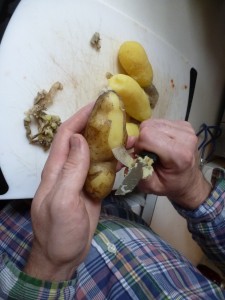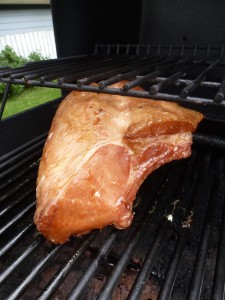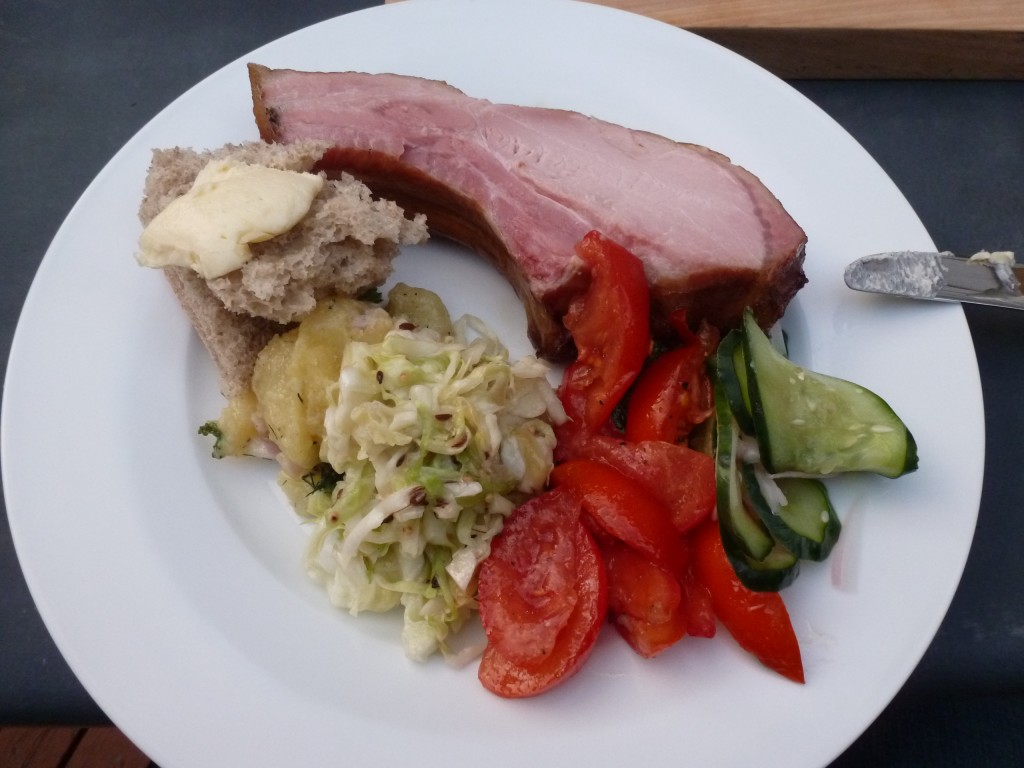I had to doublecheck my calendar: it’s still August, isn’t it?
This past Saturday I stood on my deck, wearing a sweater, tending a barbecue that was puffing applewood smoke into the yard. Within the ‘cue was a cured pork loin. Within the house, on the kitchen counter, was a head of cabbage. Beside it, a jug of cider, weakly alcoholic, tart, sweet, faintly effervescent.
I have high hopes that there will be a few more weeks of heat, and a few more summer storms, but the last few days at my house have felt like fall.
A Fall Dinner, in August
 Part One: Windfall Hard Cider (Lisa’s Special No. 8)
Part One: Windfall Hard Cider (Lisa’s Special No. 8)
The cider was the inspiration, the centre of the dinner, around which all the other components assembled.
A week previous, Judy had brought us two baskets of windfall apples. They were sweet, not tart in the slightest, and a little too mealy to be eaten out of hand. They sat in our foyer for a few days, attracting a colony of fruit flies. To stamp out the infestation, Lisa juiced all the apples on a Sunday evening. The juice was put in a tub and taken to the cool basement. Over the next few days the cider foamed and hissed. By Friday the bubbly riot had subsided. Some of the hard cider was bottled. The rest was put in a one gallon jug.
There was a polite debate about what to name this drink. It was different from the cider we pressed last fall. It came to us by surprise, in August. It was weak, with 1.032 original specific gravity, making it around 2.5% ABV. Was it therefore “Small Cider,” like the 2-3% small beers that brewers have been forced to make for different reasons at different times in history? Perhaps “Early Cider”? I struck upon “Windfall Cider”. Some one suddenly produced the charming but completely random suggestion of “Lisa’s Special No. 8”. This is an ongoing discussion.
Clearly we needed some manner of smoked pork with which to consume our cider. We had only two pieces of pork left from last year’s pig, one of them being a good section of the loin, with the ribs still attached.
Kassler Rippchen. Have you heard this term before? It literally means “little ribs from Kassel,” but refers specifically to brine-cured, smoked pork chops. As soon as the cider was stowed in the basement, I made a brine and submerged the loin. There it sat until Friday night, when I rescued it, rinsed it off, patted it dry, and let it recover, on a wire rack, in the fridge, overnight.
Saturday afternoon I smoked the rosy loin very slowly to maximize its exposure to the applewood before it reached the proper internal temperature, which by the way is about 150°F.
Part Three: Salads
Despite the presence of hard cider and cured pork and nippy weather, this was emphatically not a late-fall dinner. Yes, there was cabbage, but there were also ripe tomatoes in our backyard, brilliant red tomatoes, perched in their leafy shrubs and peering out of their cages. There was a heap of crisp cucumbers in the fridge, and a bowl of small, finger-like potatoes in the pantry.
Another funny word: Gemischtersalat. Literally “mixed salad.” The most common salad in Austria is actually a handful of different salads eaten together. At least three of the following are nestled beside each other on one plate: cabbage salad, potato salad, tomato salad, carrot salad, cucumber salad. Leaf greens may be present, but only as a decorative base.
Salad primer. Let’s start with cabbage salad. Core the cabbage. Slice thinly. Toss with salt and sugar, 1% of the weight of the sliced cabbage of each. Let stand for at least one hour, then press out as much liquid as possible. Add a simple dressing made of one part honey, one part mustard, two parts cider vinegar, and four parts canola oil. Toasted caraway seeds are good, too.
 Next potato salad, which means something very different in central Europe than in does here. Or maybe it just means something more specific than it does here.
Next potato salad, which means something very different in central Europe than in does here. Or maybe it just means something more specific than it does here.
First you must carefully consider the variety of potato to be used. It must be a creamy, yellow-fleshed variety. North American varieties like Yukon Gold are okay. Once again, stars aligned, as we had a bowl of beautiful Linzer Delikatess from Tipi Creek. These are quite simply made for German potato salad. They have the proper smooth, creamy mouthfeel, and a roughly cylindrical shape that means they slice into very consistent rounds.
Simmer the potatoes whole, in their jackets, until tender throughout. Don’t overcook them. Don’t undercook either. Remove from the water, and while the potatoes are still warm, use a paring knife to remove the skin, which should come away easily and cleanly. Slice the potatoes into rounds. Add a bit of minced onion and some of the dressing described above. I also like dill. Actually quite a bit of dill.
While I like dressing up my cabbage and potatoes with mustard and onions and other sharp flavours, with cucumbers and tomatoes I use a more delicate hand.
Tomato salad. Toss with a bit of salt and sugar. Let stand. Before serving add a touch of olive oil and fresh oregano.
Cucumber salad. As with the cabbage, toss with salt and sugar, let stand at least one hour, then press out any liquid. Add a bit of onion, and a touch of vinegar.
Set these salads side by side by side by side. You are now an initiate in the society of the Gemischtersalat. Welcome.
I promise to make the most of the few remaining weeks of summer. I really do. But I can’t wait for fall. For the wind to cool and the skies to grey and the leaves to become yellow and brittle. I can’t wait to crush more apples and smoke more pork.


